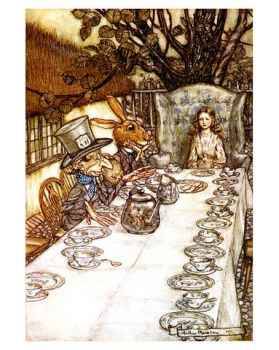Benedictines everywhere, nor any drop to drink…
This book is proving difficult to review, probably because it’s both what I expected and hoped and it’s not.
I picked up Father Joe: The Man Who Saved My Soul by Tony Hendra a couple of months ago to round out my summer reading with something I hoped would be inspirational, something that might provide new insights to my faith. What I found was more a memoir of one man’s journey to find his ultimate vocation.
Dom Joseph Warrilow is a Benedictine monk at Quarr Abbey on the Isle of Wight in the U.K. Tony Hendra is brought to the abbey to meet “Father Joe” as a 14-year-old. His first impression is that “Father Joseph Warrilow was as close to a cartoon as you could get without being in two dimensions.” And young Tony has an epiphany about his religion.
Another member of Quarr Abbey is Dom Aelred Sillem. As Mr. Hendra notes: “They represented the extremes of the Benedictine spectrum: at one end the ultraviolet of awe and order, at the other the infrared of love and community. … I never spent an hour with Dom Aelred that didn’t leave me feeling I’d been through an intellectual car wash; it was with Father Joe that I felt safe.” Dom Aelred sends the then 16-year-old Tony home with “a reading list for Mysticism 101—among others, Thomas à Kempis, Dame Julian of Norwich, the anonymous author of The Cloud of Unknowing, St. Teresa of Avila and her Franciscan mentor Bernardino de Laredo, who wrote a how-to of mystical advancement called The Ascent of Mount Sion which St. Teresa swore by. He also suggested that when I had time I should dip into the Desert Fathers, the dour, unyielding pillars of the early Church.”
The memoir follows Mr. Hendra through school and University, to his second epiphany: “I’m going to save it (the world) through laughter.” He becomes a satirist, working with Peter Cook, Dudley Moore, The National Lampoon, and others. In that heady environment, nothing is sacred—except Father Joe. Father Joe remains Tony’s “lighthouse” until the end of his very long life and Tony must deal without Father Joe.
I had a tough time with the middle of the book, where Mr. Hendra is making a good living mocking everything that has made his life possible. He hates Ronald Reagan, to the point where he credits John Paul II, Mikhail Gorbachev and “the stubborn populations of Europe—my contemporaries and their parents—who … had remained a generation of peace, refusing to buy Reagan’s famous cartoon of the Russian people or be cowed by his cowardly weapons of mass murder. After all the terror and threats and nightmare scenarios and brinkmanship, the most pointless and dangerous face-off in the planet’s history was being ended without a single shot.”
Funny—that’s not quite how I remember it. I remember Reagan challenging Mr. Gorbachev to “tear down this wall.” And many of those “stubborn populations of Europe,” including Britain, depended on the U.S. military presence for their security and to balance their national budgets. For his part, Tony lived mostly in the U.S., zipping between New York and Los Angeles, with enough money for a “country home” in New Jersey.
Mr. Hendra also notes that he, and his generation, is not without blame: “In our version, history was far worse than bunk: it was suspect, the enemy, invariably evil, a repository of constant failure and deadly delusions and appalling role models. History was when all the mistakes were made, all the atrocities committed, that time before we knew better.” He continues “To reject any vast group of one’s cultural ancestors in the cause of some current theory is not just arrogance; it’s posthumous mass murder.”
At the end of the book, Mr. Hendra has come to find his true vocation and his soul. He also discovers some amazing truths about Father Joe.
But…
I’m not sure. Mr. Hendra is an excellent writer. He seems sincere. However, Reconciliation involves not merely the confessing of our sins, but going to those we have hurt and righting any wrongs we have done to them. That’s what I sense is missing. I also find it suspect that this book is a New York Times Notable Book and that Andrew Sullivan writes that this book is “…profound…I beg you to read this book.”
And…
Mr. Hendra also makes the point that while the mighty empires of the world have all come and gone over the last fifteen hundred years, the Benedictines are still with us, with their traditions and Rule. Even further back, the religion of Jesus the Nazarene, founded on love, remains.
So how do I reconcile my religion of meekness and love in the face of the evil I see in the world today? How does “turn the other cheek” fit with a world where there are people who have no problem flying a commercial airliner into a commercial building or strapping a explosives around a young boy and sending him into a crowded market? What is the obligation of the strong to protect the weak? At what point does the strong cease being a protector, becoming, instead a bully?
Difficult questions; more difficult—and more important—than the “Reader’s Guide” questions in the back of my edition.
(For those of you made it this far and are wondering about my opening line, Benedictine monks make a liqueur called, oddly enough, “Benedictine.” Not all abbeys do; I believe there is just one in France. This liqueur was my father’s favorite. It takes some getting used to: it’s strong and not at all sweet. “Benedictine” is an acquired taste.)
Wednesday, September 07, 2005
Book Review: Father Joe
Posted by
March Hare
at
3:52 PM
![]()
Subscribe to:
Comment Feed (RSS)



|